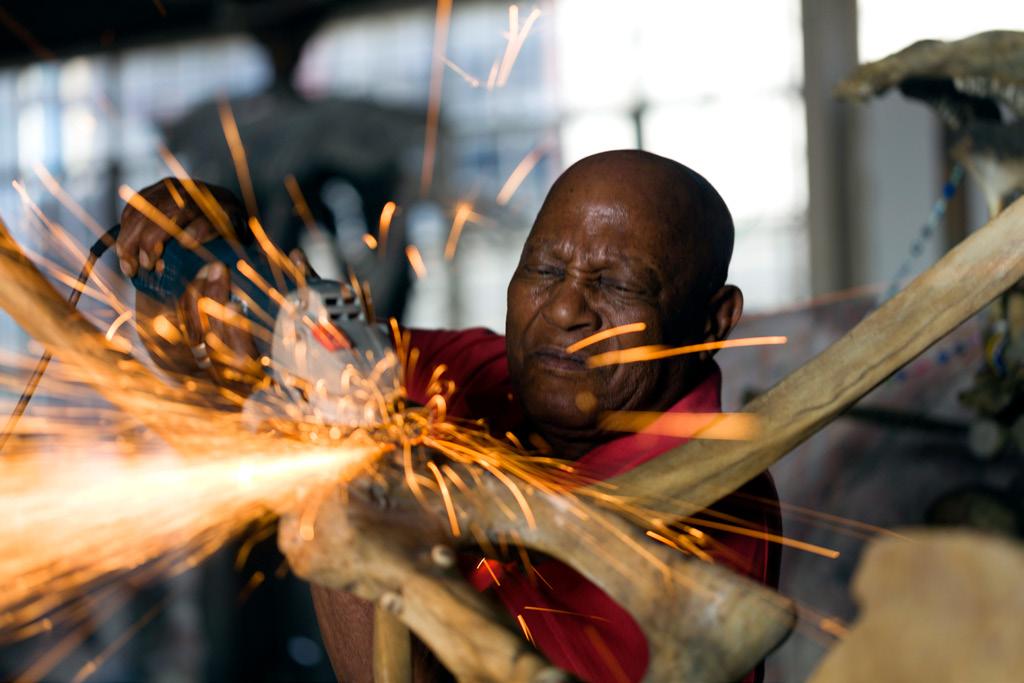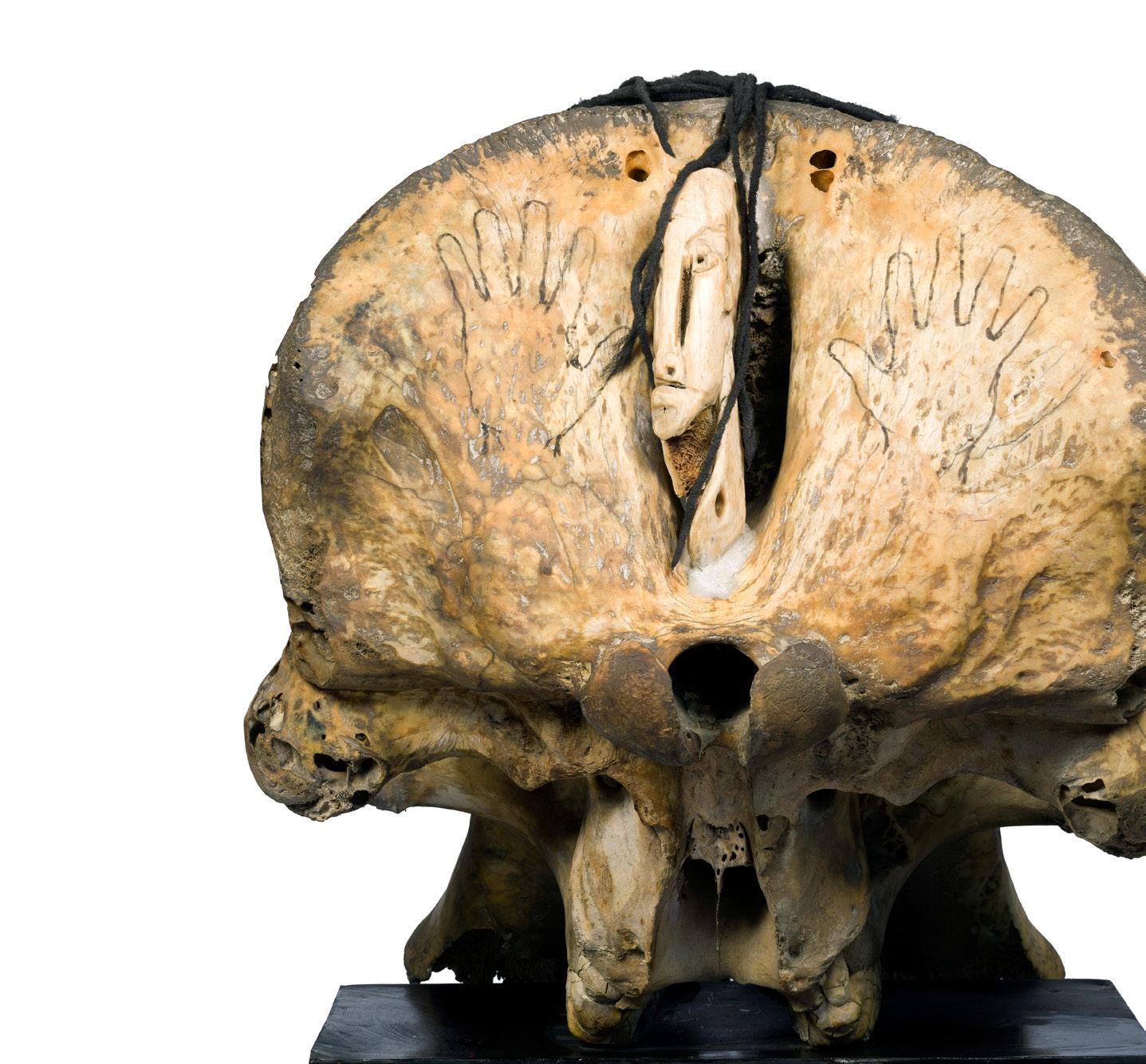
3 minute read
SANGOMA BONE SCULPTURES TEST DIGITAL AND ART REALMS
Pitika Ntuli’s exhibition debuts at virtual National Arts Festival.
Fixed definitions of ‘contemporary’ and ‘primitive art’ have haunted African art history. Launching on June 25 at the National Arts Festival, Pitika Ntuli’s novel exhibition Azibuyele Emasisweni (Return to the Source), presenting 45 bone sculptures (each with their own praise song) challenges and tests these terms, as well as how art can be enjoyed virtually.
Ntuli’s chosen material, animal bones, and approach – that of a sangoma allowing the material to guide him – invokes ancient African indigenous and spiritual knowledge systems. However, the viewer’s engagement with the sculptures takes place virtually on a multimedia platform, where images of them are seamlessly paired with words, songs and voices. The words and voices of Sibongile Khumalo, Simphiwe Dana, Zolani
Mahola, Yvonne Chaka Chaka, Gcina Mhlope, Napo Masheane and other respected musicians, poets and writers can be heard and read while viewing wrap-around footage exploring the details of the haunting animal bone sculptures. This makes for an unforgettable visual and audio experience. The first of its kind, it has been produced and conceived by the Melrose gallery, Ntuli and curator Ruzy Rusike. It was motivated by the limits COVID-19 and social distancing have placed not only on South Africa’s annual art festival but the viewing of art in person.
As a proclaimed healer, Ntuli aims to use the animal bones to explore and ‘treat’ contemporary problems: from issues plaguing the state of the nation to the strife caused by COVID-19. The eightyyear-old artist has been circling pertinent issues as an academic, writer, activist and teacher but as the title of the exhibition suggests, he is returning to ‘the source’ of his expression. In turn, he is encouraging society to return to the ‘source’ of African spiritualism and knowledge as the means of resolving corruption, greed, slavery and poverty. Above all, the bone sculptures – a result of Ntuli teasing out human features from the animal skeletons – articulate his desire for humankind to reconnect with nature.

“I do not copy nor work like nature. I work with nature. Bones are vital, as in imbued with life, and it is the life they possess that possesses me when I work. We are partners. Bones, like wood, have definite forms to work with. I do not oppose their internal and external directions, I externalise their inherent shapes to capture the beauty and the truth embedded in them – in other words, I empower the bones to attain their own ideal,” observes Ntuli.
Given the novel sculptures and haunting anthropomorphic shapes and Ntuli’s standing as a respected artist, activist and academic – he was awarded the lifetime achiever award in 2013 by the Arts & Culture Trust – Azibuyele Emasisweni (Return to the Source) was expected to be one of the main highlights on the visual arts programme at the National Arts Festival, which usually takes place in Grahamstown.
When it was announced the festival would have to transform into a virtual one, the Melrose gallery, Rusike and Ntuli worked at delivering more than just a gallery of images of sculptures.

Pitika turned to his contemporaries, inviting 33 thought and creative leaders – which also include Ngugi wa Thiong’o, Homi Bhabha, Albie Sachs, Shado Twala, Ari Sitas, Nduduzo Makhathini, Ela Gandhi, Buti Manamela, Kwesi Owusu and Lallitha Jawahirilal – to engage with his art, contributing poems, songs, thought notes, essays and dialogues to complement the sculptures in the online viewing room.
It is anticipated that these ‘artistic replies’ will greatly enrich the viewers’ experience of the exhibition. In light of the COVID-19 pandemic that is impacting so profoundly, it is likely some of the responses will contribute to ongoing discussions and debates about healing.
“Bones have a special potency and subtle spiritual energies; their endurance is legendary. We know who we are, and where we come from as a result of studying bone fossils. Bones are the evidence that we were alive 3.5 million years ago, and they are carriers of our memories,” says Ntuli.
Azibuyele Emasisweni doesn’t only lead the viewer back in time but through a unique and original use of material, form and symbolism reflects on the spiritual wasteland that might define this era, thereby collapsing those hard lines that were thought to divide ancient and contemporary concerns and art.
Azibuyele Emasisweni (Return to the Source)will run until August 2. The exhibition can be viewed on www.themelrosegallery.com and other content on www.nationalartsfestival.co.za








